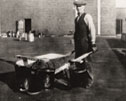Does your company perform work on roofs with slopes of 4-in-12 (18 degrees) to 8-in-12 (34 degrees)? If so, you need to know about the Occupational Safety and Health Administration's (OSHA's) recent decision to rescind a 15-year-old directive that allows slide guard use in certain residential roofing applications.
Cancellation of STD 03-00-001, "Interim Fall Protection Compliance Guidelines for Residential Construction," became effective in December 2010 with enforcement delayed until June 16, 2011. As a result, roofing contractors will have to implement conventional fall-protection methods for most residential roofing projects.
Changes
The use of slide guards was allowed under the original directive for fall protection for roofing work on residential roofs with slopes of 8-in-12 (34 degrees) or less and eave heights of 25 feet or less. Conventional fall protection, such as guardrails, safety nets or personal fall-arrest systems (PFAs), was required for roof heights exceeding 25 feet or roof slopes greater than 8-in-12 (34 degrees).
OSHA construction regulations historically have allowed a contractor performing residential construction work to implement other fall-protection measures—under provisions of a written, site-specific plan—to reduce or eliminate fall hazards if conventional means are infeasible or create a greater hazard.
In announcing its decision, OSHA headlined its intent to give "workers more safeguards against falls" by effectively eliminating the use of slide guards as one such fall-protection safeguard. OSHA provided no data or research showing slide guards were a contributing cause or even in place on projects where worker deaths occurred.
At odds
NRCA has argued, based on survey data from its members, PFAs may create greater fall hazards related to tripping and entanglement dangers from multiple lifeline placements in many roofing applications. OSHA largely has ignored such arguments and only responded to infeasibility issues as they narrowly relate to roof anchor points.
Relying in part on the residential roofing expertise of the United Steelworkers of America, OSHA concludes a good anchor point is the only component required for feasible operation of a PFA in residential roofing applications.
As for entanglement and tripping hazards, OSHA states using retractable lanyards and coordinating worker movement on a roof will mitigate those dangers.
OSHA ignores difficulties related to roof system repairs, tear-offs and installations on an occupied, fully finished structure that may limit access points, roof waste removal areas and use of guardrails, scaffolding or powered lift equipment as fall-protection alternatives in reroofing projects. Some conditions also may interfere with the effective use of PFAs.
Due diligence
In operating their businesses, roofing contractors have to perform due diligence, a precept that requires a business person to exercise a standard of care to investigate critical decisions that need to be made when running his or her business.
Similarly, OSHA policy and rulemaking should incorporate a principle of due diligence. The cancellation of the slide guard rule reflects a serious misconception by the agency of the type of work roofing contractors perform and a broader lack of research and investigation into the nature of falls in construction.
The effectiveness of a fall-protection system in roofing or any other industry should be determined by proper analytical evidence of its ability to prevent injuries. Restricting or eliminating the use of a fall-protection system without adequate supporting research or evidence does not qualify as due diligence appropriate to a federal agency entrusted with worker safety.
Harry Dietz is NRCA's director of risk management.



